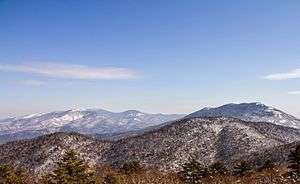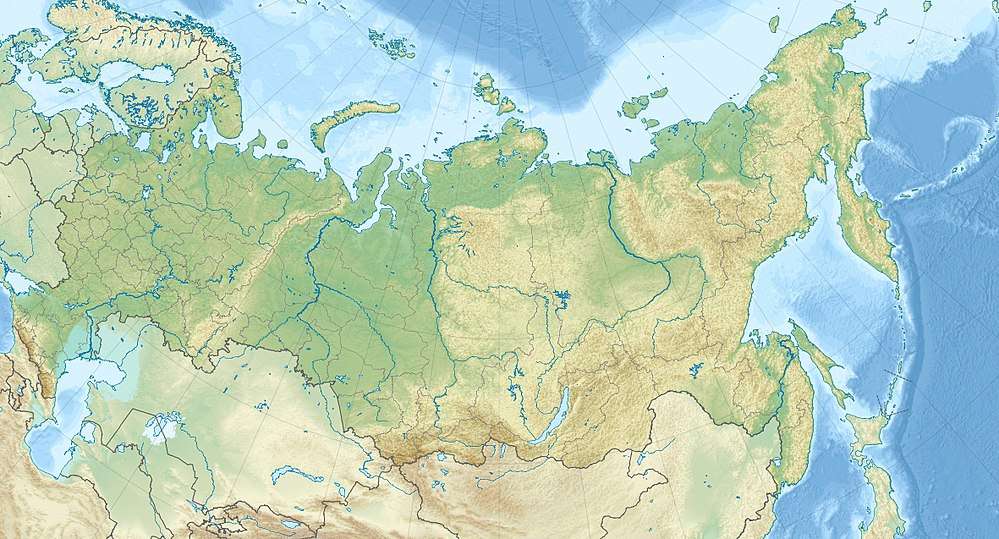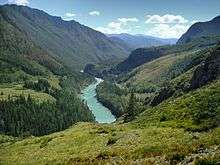Sikhote-Alin
The Sikhote-Alin (Russian: Сихотэ́-Али́нь, Russian pronunciation: [sʲɪxɐˈtɛ ɐˈlʲinʲ], English: /ˈsiːkəˌteɪ əˈliːn/, SEE-kə-TAY ə-LEEN) is a mountain range in Primorsky and Khabarovsk Krais, Russia, extending about 900 kilometres (560 mi) to the northeast of the Russian Pacific seaport of Vladivostok. The highest summits are Tordoki Yani at 2,077 metres (6,814 ft) above sea level, Ko Mountain (2,003 m) in Khabarovsk Krai and Anik Mountain (1,933 m) in Primorsky Krai.
| Sikhote-Alin | |
|---|---|
 Sikhote-Alin is the home to Amur tigers, which are amongst the largest felines in the world[1] | |
| Highest point | |
| Peak | Tordoki Yani, Russia |
| Elevation | 2,090 m (6,860 ft) |
| Coordinates | 45°20′N 136°10′E |
| Geography | |
 Sikhote-Alin | |
| Climbing | |
| Official name | Central Sikhote-Alin |
| Type | Natural |
| Criteria | x |
| Designated | 2001 (25th session) |
| Reference no. | 766 |
| Region | Europe and North America |
Geography
Although Sikhote-Alin is a temperate zone, species typical of northern taiga (such as reindeer and the Ussuri brown bear) coexist with the leopard, tiger and Asiatic black bear. The region holds very few wolves, due to competition with tigers.[2] The oldest tree in the region is a millennium-old Japanese yew.[3]
The core zone can only be explored in a company of rangers.
History
The name is thought to be of Manchu origin (Manchu: alin "mountain").
In the 1910s and 1920s, Sikhote-Alin was extensively explored by Vladimir Arsenyev (1872–1930) who described his adventures in several books, notably Dersu Uzala (1923), which in 1975 was turned into an Oscar-winning film by Akira Kurosawa. The large Sikhote-Alin and Lazo wildlife refuges were set up in 1935 to preserve the region's unusual wildlife.
On February 12, 1947, one of the largest meteor showers in recent history occurred in the Sikhote-Alin mountains. The Sikhote-Alin meteorite exploded in the atmosphere as it fell, raining many tons of metal on an elliptical region about 1.3 square kilometres (0.50 sq mi) in area. Craters were formed by the meteors; the largest was 26 metres (85 ft) in diameter.
In 2001, UNESCO placed "Central Sikhote-Alin" onto the World Heritage List, citing its importance for "the survival of endangered species such as the scaly-sided (Chinese) merganser, Blakiston's fish-owl and the Amur tiger". The World Heritage site had a total area of 16,319 square kilometres (4,033,000 acres), of which the terrestrial core zone of Sikhote-Alin Zapovednik comprised 3,985 square kilometres (985,000 acres).[4] In 2018, the World heritage site was expanded by 11,605 square kilometres (2,868,000 acres) by including Bikin National Park under the name "Bikin River Valley".[5]
References
- Slaght, J. C., D. G. Miquelle, I. G. Nikolaev, J. M. Goodrich, E. N. Smirnov, K. Traylor-Holzer, S. Christie, T. Arjanova, J. L. D. Smith, Karanth, K. U. (2005) Chapter 6. Who's king of the beasts? Historical and recent body weights of wild and captive Amur tigers, with comparisons to other subspecies. Pages 25–35 in: Miquelle, D.G., Smirnov, E.N., Goodrich, J.M. (Eds.) Tigers in Sikhote-Alin Zapovednik: Ecology and Conservation. PSP, Vladivostok, Russia (in Russian)
- "Tigers and Wolves in the Russian Far East: Competitive Exclusion, Functional Redundancy, and Conservation Implications". savethetigerfund.org. Archived from the original on 2007-10-30. Retrieved 2008-07-09.
- "Archived copy". Archived from the original on 2007-09-29. Retrieved 2007-09-29.CS1 maint: archived copy as title (link) Nature Monument "Sikhote - Alin". Center for Wildlife Rehabilitation "UTES" (in Russian)
- "Central Sikhote-Alin - Russian Federation" (PDF). United Nations Environment Programme
- "Bikin River Valley". UNESCO. Retrieved 3 July 2018.
External links
| Wikimedia Commons has media related to Sikhote-Alin. |
| Wikivoyage has a travel guide for Sikhote-Alin. |
- Sikhote-Alin at the Encyclopædia Britannica
- UNESCO — Sikhote-Alin World Heritage Site
- Natural Heritage Protection Fund: Central Sikhote-Alin - at Natural Heritage Protection Fund
- Zhuravlev, Yu. N., ed. (2000) Стратегия сохранения биоразнообразия Сихотэ-Алиня = A Biodiversity Conservation Strategy for the Sikhote-Alin' Vladivostok: Russian Academy of Sciences, Far Eastern Branch





